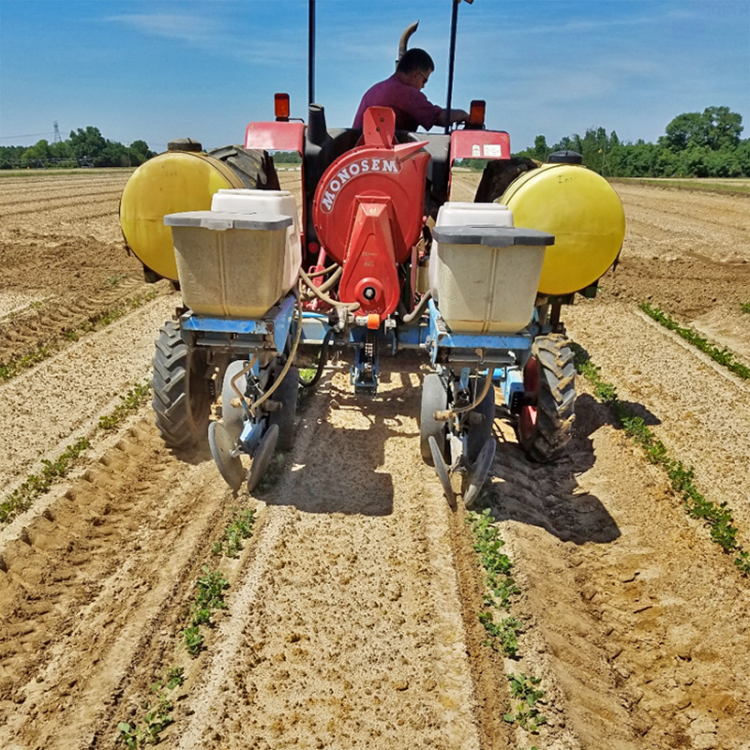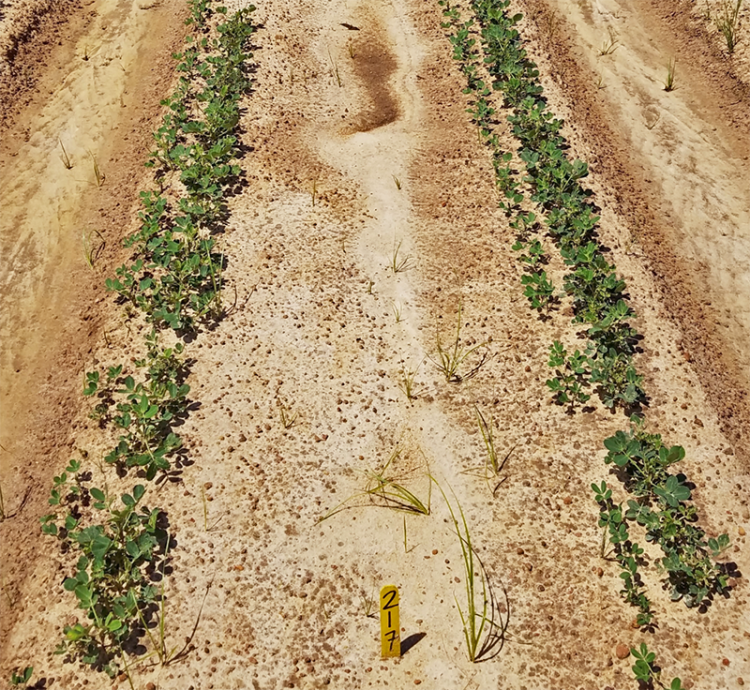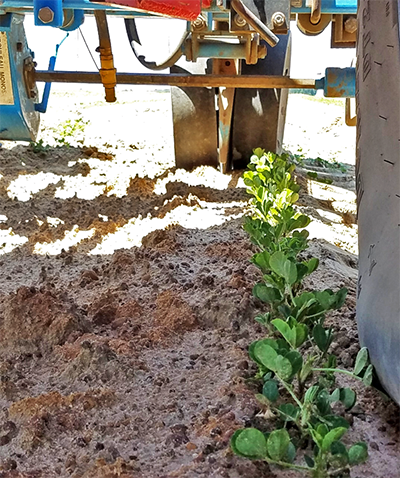Mike Mulvaney, UF/IFAS West Florida Research and Education Center, & Scott Tubbs, UGA Coastal Plain Experiment Station

Figure 1. Supplemental replanting of peanut next to the initial stand will help recover yield when the initial stand is less than 2.5 plants/foot in single rows, or less than 3 plants/foot in twin rows. Do not terminate the initial stand. Photo credit: Scott Tubbs, UGA.
It’s the time of year when producers often face decisions involving replanting peanut. This is always a tough call, there are many factors to consider including, should the existing crop be terminated or supplemented and how single vs. twin rows effects the situation. Researchers at the University of Georgia have conducted a multi-year research trial to help producers better answer these questions.
The recommended peanut planting rate is 6 seeds/ft in order to achieve a minimum of 4 plants/ft. But there are a lot of reasons we might not end up with an acceptable stand. Chief among these seems to be seed quality issues, but there are other reasons a stand might not be acceptable, such as disease, improperly calibrated equipment, traveling too fast, or sub-optimal soil conditions (temperature and moisture especially). The question is, what is an acceptable stand? And what do we do if we don’t have an acceptable stand?
–
Single Row
Recent work at UGA on single row peanut showed that yield is increased by supplemental replanting when stands were below 2.5 plants per foot (Sarver et al., 2016). In this case, supplemental replanting was achieved by planting 3.5 inches off the original row. When stands were 2.5 plants/foot, a reduced replant rate of 3 seed/ft was used. The authors emphasize that killing the existing stand and completely replanting the field was never the best option.
–
Twin Rows
On twin rows, re-planting was warranted when stands were at 3 plants/foot or less (Sarver et al., 2017). In this case, supplementing the initial stand by replanting a single row (i.e., filling only one hopper) in between the twin rows increased yield by 8.3%, although replanting twin rows (with one row between and one row outside the original twin rows) increased yield by 6.6%, as compared to no supplemental replanting. If initial stands are less than 3 plants/foot in twin rows, agronomically the best option is to supplement the initial stand with a reduced seed rate, rather than kill the existing crop and completely replanting. At 3 plants/foot, the replant rate used in the UGA study was 3 seed/foot and decreased as the initial plant population increased.
–

Figure 3. Replanting 3.5 inches from the initial stand at a rate of 3 seeds/foot was the best strategy to recover lost yield. Photo credit: Scott Tubbs, UGA.
–
Take Home Message
In both these studies, destroying the initial stand and completely replanting was never beneficial. Based on a rough estimate of economics, it was economically beneficial to replant when plants were below (not equal to) 2.5 plants/foot.
Management of a crop with two maturities can be tricky. Fortunately, again, our UGA colleagues have been evaluating this as well. Although there wasn’t much of a difference in yield, based on digging for the early or late crop, grade was consistently improved by waiting later to dig. This gives the replanted crop time to mature, so that there are more mature pods from both crops. If the vines are healthy and environmental conditions are favorable to promote maturity, UGA recommends digging the pods later. Of course, sometimes you just have to get the crop out while you can.

Figure 4. Supplemental replanting of peanut means you’ll have crops with two different maturities, presenting a challenge for management and harvest decisions. Photo credit: Scott Tubbs, UGA.
–
References:
Sarver, J. M., Tubbs, R. S., Jr., J. P. Beasley, Culbreath, A. K., Grey, T. L., Rowland, D. L., & Smith, N. B. (2016). Plant population and replant method effects on peanut seeded in single rows. Peanut Science, 43(2), 126-132
Sarver, J. M., Tubbs, R. S., Jr., J. P. Beasley, Culbreath, A. K., Grey, T. L., Rowland, D. L., & Smith, N. B. (2017). Evaluating Plant Population and Replant Method Effects on Peanut Planted in Twin Rows. Peanut Science, 44(1), 19-25.
R.S. TUBBS, and W.S. MONFORT, Crop and Soil Sciences Department, University of Georgia, Tifton, GA 31793. Timing of Termination for Supplemental Replanted Peanut to Maximize Yield and Grade. Page 127. 51st Annual Meeting American Peanut Research and Education Society Proceedings of the July 9-11, 2019 * Auburn, AL
- Four Early-Season Lessons from 2020 Peanut Production - April 9, 2021
- Sprayer Calibration Tables – Calibration Made Easy - October 30, 2020
- Stand Issues – Should You Replant Your Peanut Field? - May 15, 2020

